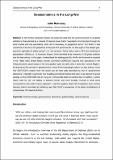| dc.contributor.author | Morrissey, John | |
| dc.date.accessioned | 2017-10-04T13:45:23Z | |
| dc.date.available | 2017-10-04T13:45:23Z | |
| dc.date.issued | 2015-09-15 | |
| dc.identifier.citation | Morrissey, John. (2017). Geoeconomics in the Long War. Antipode, 49, 94-113. doi: 10.1111/anti.12183 | en_IE |
| dc.identifier.issn | 1467-8330 | |
| dc.identifier.uri | http://hdl.handle.net/10379/6856 | |
| dc.description.abstract | In Neil Smith's American Empire (2003, University of California Press), he makes the case that the current moment of US global ambition is characterized by a network of imperial power that is exercised in the first place through the world market and only secondarily, when and if necessary, in geopolitical terms. For Smith, it was crucial that in the din of US geopolitics in the post-9/11 period we did not lose sight of the deeper geo-economic aspiration for global control, in a war on terror that is really a war to fill in the interstices of globalization (p xiv). In American Empire, Smith identified three moments of US global ambition over the last century. In this paper, I extend back the starting point for Smith's third moment to a period in the 1990s when United States Central Command (CENTCOM) became fully operational in the military-economic securitization of the most pivotal region on earth, what it terms the Central Region. By drawing on the concept of geoeconomics, which Smith increasingly used in his later writing, I show how CENTCOM's mission from the outset can be most aptly described as one of geoeconomic deterrence. I highlight in particular how enabling commercial markets has been a key element of grand strategy in what CENTCOM calls its long war in the Middle East and Central Asia. In addition, I outline recent calls for the US military to become further and more broadly involved in what some commentators have called messy capitalism. I ask the question what kind of capitalism and in whose interests, before concluding by reflecting upon Neil Smith's assessment of the fated contradictions of contemporary US imperial ambition. | en_IE |
| dc.format | application/pdf | en_IE |
| dc.language.iso | en | en_IE |
| dc.publisher | Wiley | en_IE |
| dc.relation.ispartof | Antipode | en |
| dc.rights | Attribution-NonCommercial-NoDerivs 3.0 Ireland | |
| dc.rights.uri | https://creativecommons.org/licenses/by-nc-nd/3.0/ie/ | |
| dc.subject | American empire | en_IE |
| dc.subject | Geoeconomics | en_IE |
| dc.subject | Deterrence | en_IE |
| dc.subject | Grand strategy | en_IE |
| dc.subject | National security | en_IE |
| dc.title | Geoeconomics in the Long War | en_IE |
| dc.type | Article | en_IE |
| dc.date.updated | 2017-10-03T09:14:05Z | |
| dc.identifier.doi | 10.1111/anti.12183 | |
| dc.local.publishedsource | http://dx.doi.org/10.1111/anti.12183 | en_IE |
| dc.description.peer-reviewed | peer-reviewed | |
| dc.contributor.funder | |~|1267880|~| | |
| dc.internal.rssid | 12261915 | |
| dc.local.contact | John Morrissey, Room 111 Geography, National University Of Ireland, , University Road, Galway. 2267 Email: john.morrissey@nuigalway.ie | |
| dc.local.copyrightchecked | No | |
| dc.local.version | ACCEPTED | |
| nui.item.downloads | 776 | |


